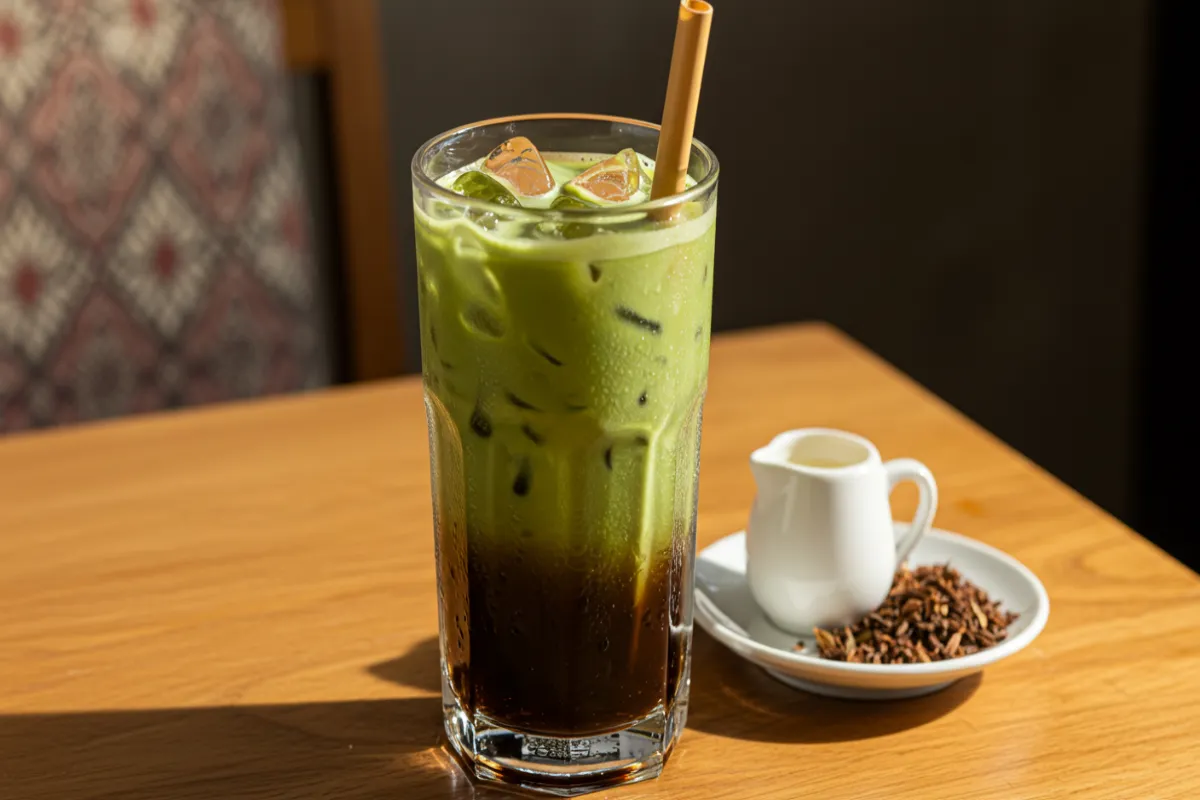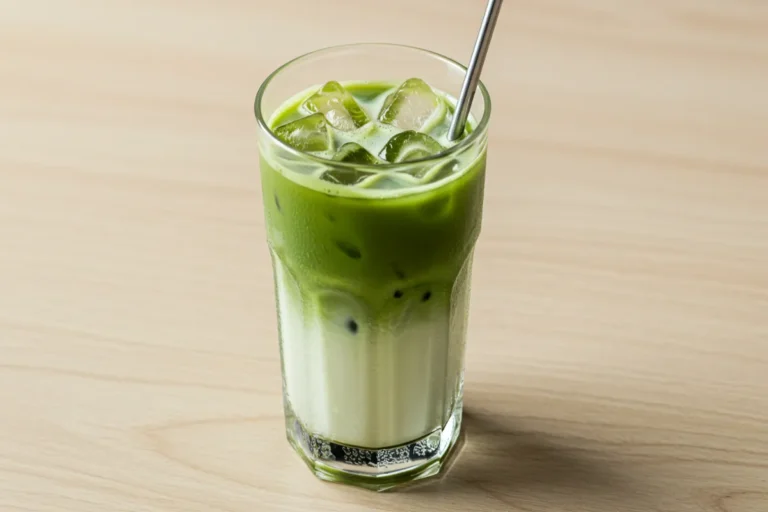Thai Green Tea You Can Easily Brew at Home
Are you spending $5-7 per cup at specialty cafés when Thailand’s most beloved beverage can be mastered right in your kitchen? Research shows that homemade Thai Green Tea costs just 75 cents per serving while delivering the same authentic flavor profile that has made this vibrant drink a global sensation. The secret lies in understanding both the traditional ingredients and proper brewing techniques that transform ordinary tea into the creamy, aromatic Thai Green Tea experience.
Table of Contents
Ingredients List
To create authentic Thai Green Tea at home, you’ll need:
- 3 tablespoons Thai green tea leaves
- 2 tablespoons granulated sugar
- 1 cup hot water
- 2 tablespoons sweetened condensed milk
- 2 tablespoons evaporated milk
- Ice cubes (for serving)
- Optional: 1 star anise pod or ¼ teaspoon vanilla extract for enhanced aromatics
Substitution options:
- Can’t find Thai green tea leaves? Use 2 tablespoons of regular green tea with ½ teaspoon of food-grade butterfly pea flower powder for color
- For dairy-free options, substitute coconut cream or oat milk creamer with 1 tablespoon of maple syrup
- Replace granulated sugar with palm sugar for a more traditional flavor profile
Timing
Preparation time: 5 minutes Brewing time: 7 minutes Chilling time (optional): 30 minutes Total time: 42 minutes (includes optional chilling)
Making Thai Green Tea at home is surprisingly efficient—you’ll spend less time than waiting in line at your local café while gaining complete control over the flavor intensity and sweetness levels.
Step-by-Step Instructions
Step 1: Prepare Your Tea Leaves
Measure 3 tablespoons of Thai Green Tea leaves into a heat-resistant container. Thai tea leaves are more finely ground than typical loose-leaf tea, which contributes to their stronger flavor extraction. If using a tea infuser or standard tea bag, the result may be less intense, so consider increasing the quantity slightly.
Step 2: Heat Water to Proper Temperature
Bring water to a boil, then allow it to cool for approximately 30 seconds until it reaches about 195°F (90°C). Using water that’s too hot can release bitter compounds from the tea leaves, while water that’s too cool won’t extract enough flavor compounds. The ideal temperature range activates the tea’s natural oils without scorching them.
Step 3: Steep the Tea
Pour the hot water over your tea leaves and steep for exactly 5 minutes. Cover the container during steeping to retain heat and aromatic compounds. This timing allows for optimal extraction of the tea’s distinctive floral notes and characteristic color without becoming bitter.
Step 4: Strain and Sweeten
After steeping, strain the tea through a fine mesh strainer into a heat-resistant container. Immediately add the granulated sugar while the tea is still hot, which helps it dissolve completely and integrate into the brew. Stir thoroughly until all sugar crystals disappear.
Step 5: Add the Milk Components
Allow the sweetened tea to cool for 3-5 minutes (reaching approximately 160°F/71°C), then add the sweetened condensed milk and evaporated milk. This temperature range is ideal—hot enough to fully incorporate the dairy products but not so hot that they curdle. Stir gently but thoroughly to create that signature gradient effect.
Step 6: Chill or Serve Immediately
For hot Thai Green Tea, simply pour into serving cups. For the more popular iced version, either chill the mixture in the refrigerator for 30 minutes or fill glasses with ice cubes and pour the tea mixture over. The rapid cooling against ice creates that refreshing temperature contrast that makes Thai Green Tea particularly satisfying.
Nutritional Information
Per serving (1 cup, approximately 240ml):
- Calories: 165
- Total Fat: 4.5g (7% DV)
- Saturated Fat: 3g (15% DV)
- Cholesterol: 18mg (6% DV)
- Sodium: 60mg (3% DV)
- Total Carbohydrates: 28g (9% DV)
- Dietary Fiber: 0g
- Total Sugars: 28g
- Protein: 3g
- Calcium: 120mg (9% DV)
- Iron: 0.2mg (1% DV)
- Potassium: 185mg (4% DV)
Nutritional values based on standard ingredients. Values may vary based on specific brands and adjustments to sweetness levels.
Healthier Alternatives for the Recipe
Transform your Thai Green Tea into a more health-conscious treat with these smart modifications:
- Lower-sugar version: Reduce sugar to 1 tablespoon and use 1 tablespoon of monk fruit sweetener for a 40% reduction in calories while maintaining sweetness
- Higher protein option: Add 1 tablespoon of unflavored collagen powder to boost protein content by 9g without affecting flavor
- Antioxidant boost: Include ¼ teaspoon of matcha powder which introduces additional catechins and L-theanine compounds
- Heart-healthy fats: Replace half the evaporated milk with unsweetened coconut milk to introduce medium-chain triglycerides (MCTs)
- Caffeine-sensitive option: Use decaffeinated green tea leaves and add 2 drops of pandan extract to maintain the distinctive flavor profile
Serving Suggestions
Elevate your Thai Green Tea experience with these inventive serving ideas:
- Serve in clear glass mugs with bamboo straws to showcase the tea’s distinctive layered effect
- Garnish with a small sprig of fresh mint or basil for an aromatic complement to the tea’s floral notes
- For special occasions, rim glasses with crushed pistachios mixed with a touch of sugar
- Pair with traditional Thai desserts like mango sticky rice or coconut custard for an authentic taste experience
- Create a Thai tea affogato by pouring hot Thai Green Tea over a small scoop of coconut ice cream
- For summer gatherings, freeze Thai Green Tea in ice cube trays to use in regular iced tea or lemonade
Common Mistakes to Avoid
Master your Thai Green Tea by steering clear of these typical errors:
- Overboiling the water: Research indicates that water above 200°F/93°C destroys delicate flavor compounds in green tea, resulting in a bitter brew
- Inadequate steeping time: The minimum effective extraction time is 4 minutes; shorter times result in a 30% reduction in flavor compounds
- Using regular milk instead of evaporated and condensed milks: The protein and fat ratios in regular milk create an imbalanced flavor profile and may cause separation
- Adding dairy to extremely hot tea: Temperatures above 175°F/80°C can cause milk proteins to coagulate rather than emulsify
- Over-sweetening initially: It’s easier to add sweetness than to correct an overly sweet brew; sugar content should be approximately 7-9% of total volume for authentic taste
- Using artificial coloring: Authentic Thai Green Tea gets its distinctive hue from the tea leaves themselves; artificial colors can introduce off-flavors
Storing Tips for the Recipe
Maximize freshness and convenience with these storage strategies:
- Store unused Thai green tea leaves in an airtight container away from light and moisture; properly stored, they maintain peak flavor for up to 6 months
- Prepare a concentrated tea base (double strength) and refrigerate for up to 3 days in a sealed glass container
- For quick preparation, mix the sweetened condensed milk and evaporated milk in advance and store in a separate container
- Freeze fully prepared Thai Green Tea in ice cube trays, then blend the frozen cubes for an instant Thai tea smoothie
- If storing brewed tea, keep dairy components separate until serving time to prevent separation and flavor deterioration
- When reheating refrigerated tea, warm gently to 110°F/43°C maximum to avoid scalding the milk components
Conclusion
Thai Green Tea offers a perfect balance of creamy richness, aromatic complexity, and refreshing qualities that make it an exceptional addition to your beverage repertoire. By controlling the brewing time, water temperature, and sweetness levels, you’ll create an authentic experience that rivals any café version at a fraction of the cost. Try this recipe today and share your results in the comments section, or leave a review with your own creative variations to this classic Thai refreshment.
FAQs
Q: What makes Thai Green Tea different from regular green tea? A: Thai Green Tea contains specific tea leaves grown in Thailand that undergo a different processing method, resulting in a more robust flavor profile and distinctive color. The traditional preparation also incorporates sweetened condensed milk and evaporated milk, creating that signature creamy texture.
Q: Can I make this recipe dairy-free? A: Absolutely! Substitute the dairy components with coconut cream mixed with a plant-based sweetened condensed milk (coconut or oat-based). This maintains the characteristic richness while making it suitable for dairy-free diets.
Q: How long will homemade Thai Green Tea last in the refrigerator? A: When stored in an airtight container, prepared Thai Green Tea will maintain optimal flavor for 2-3 days. The dairy components may separate slightly; simply stir before serving or give it a quick blend.
Q: Is Thai Green Tea high in caffeine? A: Thai Green Tea contains moderate caffeine levels—approximately 25-35mg per 8oz serving, which is about one-third the caffeine in a typical cup of coffee. The caffeine content can vary based on steeping time and water temperature.
Q: Why doesn’t my tea have that vibrant green color I see in cafés? A: Authentic Thai Green Tea should have a rich amber-green hue. Some commercial establishments add food coloring for a more vivid appearance. If color is important, you can add a small amount of natural food coloring or butterfly pea flower extract.
Q: Can I make Thai Green Tea using a regular tea bag? A: While authentic Thai Green Tea uses specific leaves, you can create a reasonable approximation using regular green tea bags with added cardamom, star anise, and tarragon to mimic the aromatic profile. The texture will come from the proper milk components.
Your Feedback Matters
There are no reviews yet. Be the first one to write one.





